QuestionHi,
I took in a mouse a couple months ago from a litter my boss had. Groucho a brown male, only about 4 months old and he lives by himself.
His brother's and sisters, as well as his mom all died under my boss's care and she doesn't know why. Since then I've been observing Groucho pretty closely for signs of illness. I noticed a week ago he was sneezing here and there. Then I noticed he seemed to be scratching a lot.
I thought maybe I should change the bedding I was using, which I did, and he's still itching and sneezing. Tonight, I noticed his back had spots. Upon further inspection I was horrified to see small patches of fur gone and redness of his skin. It also feels as though there are tiny bumps, and he's been itching and cleaning himself a lot.
I thought it might be mites judging from how much he itches. However, where I live, there aren't any vets that will see a mouse and I only have major pet chains at my disposal like Petco and Petsmart, so I'm at a loss for what to do. Are there any home remedies or other possible reasons Groucho would have these symptoms? I'd like him to get relief as quickly as possible.
Thank you in advance!
AnswerDear Gwen,
The sneezing and itching could be from an allergy, or could be from both a respiratory infection and mites. If he has mites, the bumps and bald spots are from the scratching. Those are the most common and likely possibilities. If a vet visit were possible I would strongly recommend it, but since that isn't the case, you can treat at home.
I suggest you start by treating for the latter possibility. You will want to treat for both mites and the respiratory infection.
I am cutting and pasting some of these directions from various of the questions in my archives, so please don't mind if it says she instead of he!
Here are directions for treating for
RESPIRATORY INFECTION:
Mice are always carriers of a respiratory bacteria called Mycoplasma pulmonis (myco). When they get sick, they either have myco, or myco *and* something else (a secondary infection). Usually treating them for one is sufficient, and their symptoms will subside. If you went to a vet, you would probable be given Baytril or Doxycycline and Amoxicillin in case there is a secondary infection.. I do know how to get these medications without a prescription, but I am not confident in my ability to dose them for you correctly (remember, I have no medical traininge and don't claim to.... please don't downgrade me for this!). Also that would take a while. However, there is an antibiotic, though not quite as strong, which you can easily get at one of your big box pet stores (Petco and Petsmart). Do the following:
Pick up a bottle of Tetracycline from the FISH section.
You are going to put some in her water bottle and try to get an initial dose inside her.
If you have the capsules, empty one capsule into a large water bottle or one half into a small one. Shake extremely well. If you have the powder, 1/4 flat teaspoon measure is the same as 1 capsule. If you have the tablets, completely crush them into fine powder with the back of a spoon and use as powder. This should be her only water source. Cover the bottle of water with tin foil, because tetracycline reacts with light. Change every few days for ten days.
Next, take another capsule worth and mix it with one drop of water. This will make a paste about the consistency of mustard. You have plenty to play with, so if the mixture is too watery, try again. Now pick up the mouse by the scruff of the neck. This is the skin just behind her head. This does not hurt her-- it's how her mama used to carry her-- but she will struggle valiantly. Holding her gently but firmly, quickly place a small amount into her now open mouth. This is hard. Be careful of her nose! Wipe a bit more onto her whiskers and chin. She will ingest that when she washes herself. If you couldn't get any inside her at all, wipe some more on her head and sides. Put her back into her cage so she will wash herself.
At the same time, you should treat for mites.
MITES
To remove parasites, I use the flea and tick spray from 8-in-1. For a mild case I recommend the BIRD spray, which is gentler than the rodent version. You can find both of these at your big box pet store.
After reading the directions carefully, shake the can well. Spray the mouse from a few inches away and rub the liquid in until all of her fur is soaked. Do this over a bed or with someone holding onto her tail, because a wet mouse can jump. Although I use my hands, the label does say not to let it touch your skin. If you don't want to get it on your hands then put rubber gloves on and use a small sponge, which you very liberally cover with the liquid spray, and rub it all over the mouse's fur.
Make sure she is warm and absolutely dry before you return her to the cage. Her cage must be completely cleaned and rinsed and all bedding and toys must be new, with the exception of plastic items which you wash carefully or boil, or glass. I don't recommend saving any wooden or porous items. If you really want to keep them, freeze them for 48 hours before putting them back.
The spray is pretty strong stuff, and some mice suffer some skin pain within a few hours, which can last perhaps 12 hours. If Mousie squeaks when touched or even when alone in the nest, all you can do is give her your condolences. She will feel better soon. This only happens to some mice. The bird spray is far less likely to cause this. It's definitely no reason not to treat the mouse, though.
If, after 2-3 days, this has helped, then repeat the entire procedure 7-10 days later. This will kill off the mites which were protected inside eggs when you first sprayed.
If it helps but does not completely cure the problem, you will have to use the stronger, rodent version of the spray. Use the same procedure.
If these treatments don't help within 5 days, it is time to test for allergies.
ALLERGIES
The next step that I would take is to strip down her environment to as hypoallergenic a situation as possible and see what happens. This is going to be complicated, but you love her very much so I'm sure you won't mind.
Clean her cage and plastic/metal accessories just by washing thoroughly with with water. Then just give her paper towels as bedding. For food give her oats. Make sure you use no chemicals in the room at all-- no air freshener, furniture polish, cleaning agents, etc. Do this for 3 days and see if the symptoms recede.
After that, start to add types of food. If she has a seed mix, you will want to separate out the seeds by hand! You can change something every day, but if she sneezes you will want to go back about three days worth of materials. At some point when she has a somewhat varied diet, the change you can make is to give her decent bedding again. If you use wood, the *only* safe kind is aspen. Do sunflower seeds, and then corn, last, because they are common allergens. Never give a mouse peanuts; and if they are in the mix, always take them out.
As I said, go back three days' worth of changes if she begins sneezing or itching again, and try something else instead of what you tried. This way you will find out what she is allergic to.
OR
If the antibiotics and the allergen tests don't work, I would recommend both trying to find a vet to ask online, or on the phone. There is an online vet that I know of-- Dr Karen Rosenthal, on the Small Animals Channel:
http://www.smallanimalchannel.com/critter-experts/vet/topiclist.aspx
I hope Groucho gets better quickly. It's too bad about his family. If you let me know what their symptoms were, I might be able to guess a cause of death. If they had either of his symptoms, both mites and respiratory infections kill mice.
Best of luck.
squeaks,
Natasha

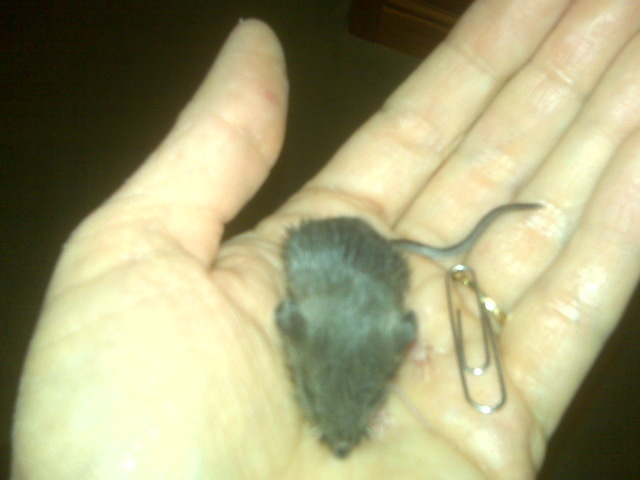 orphaned baby field mouse
QuestionQUESTION: Two days ago we trapped and released
orphaned baby field mouse
QuestionQUESTION: Two days ago we trapped and released
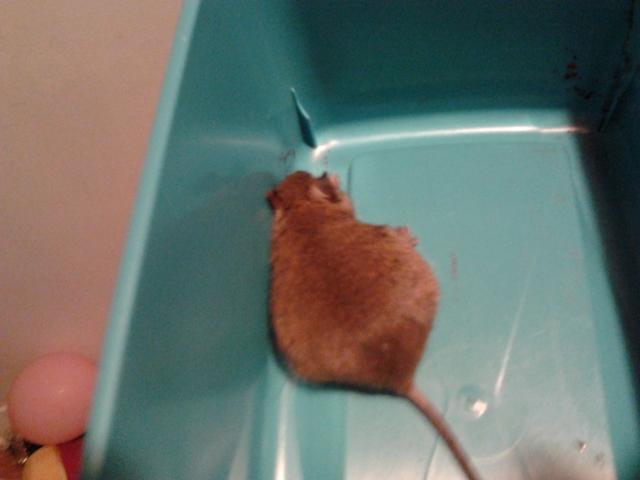 First mouse found
Question
Cinnamon?
Hi Tamarah,
&nb
First mouse found
Question
Cinnamon?
Hi Tamarah,
&nb
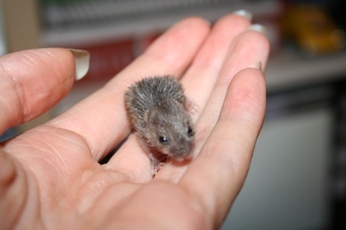 Am I hand-rearing my wild house mouse pup right?
Question
The little Pipsqueak
Hi Tamarah,
About 5 ago
Am I hand-rearing my wild house mouse pup right?
Question
The little Pipsqueak
Hi Tamarah,
About 5 ago
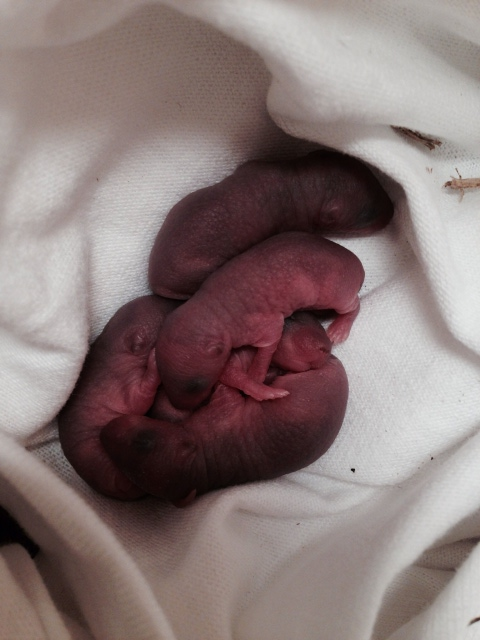 What to do with 5 orphan mice
Question
Day#1
Aloha, I found 5 tiny pink mice i
What to do with 5 orphan mice
Question
Day#1
Aloha, I found 5 tiny pink mice i
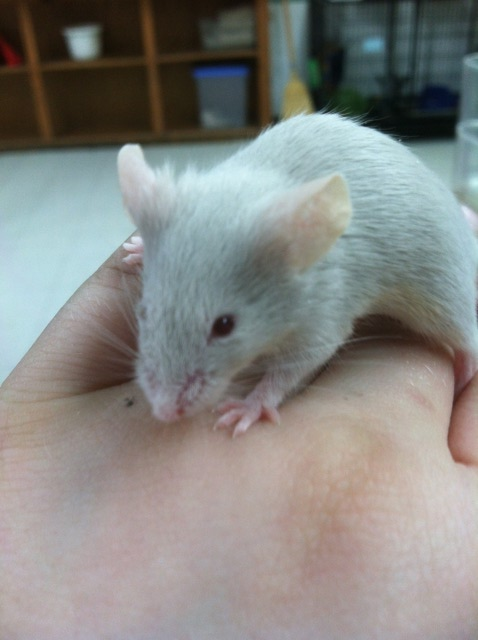 Pet baby mouse too young?
Question
Mouse
Hi, someone just gave me a baby m
Pet baby mouse too young?
Question
Mouse
Hi, someone just gave me a baby m